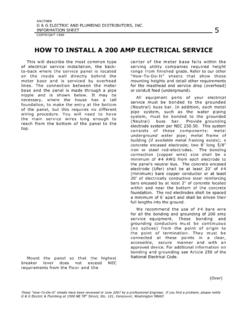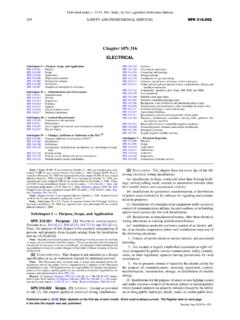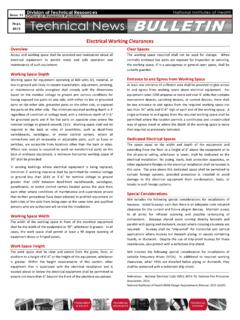Transcription of Discrete Stochastic Processes, Chapter 7: Random Walks ...
1 Chapter 7 Random Walks , LARGE DEVIATIONS, AND MARTINGALES Introduction Definition Let {Xi; i 1} be a sequence of IID Random variables, and let Sn = X1 + X2 ++ Xn. The integer-time Stochastic process {Sn; n 1} is called a Random walk, or, more precisely, the one-dimensional Random walk based on {Xi; i 1}. For any given n, Sn is simply a sum of IID Random variables, but here the behavior of the entire Random walk process, {Sn; n 1}, is of interest. Thus, for a given real number > 0, we might want to find the probability that the sequence {Sn; n 1} contains any term for which Sn ( , that a threshold at is crossed) or to find the distribution of the smallest n for which Sn.
2 We know that Sn/n essentially tends to E [X] = X as n 1. Thus if X< 0, Sn will tend to drift downward and if X > 0, Sn will tend to drift upward. This means that the results to be obtained depend critically on whether X< 0, X> 0, or X = 0. Since results for X > 0 can be easily found from results for X < 0 by considering { Sn; n 1}, we usually focus on the case X < 0. As one might expect, both the results and the techniques have a very different flavor when X = 0, since here Sn/n essentially tends to 0 and we will see that the Random walk typically wanders around in a rather aimless With increasing n, Sn increases as n (for X both zero-mean and non-zero-mean), and this is often called 1 When X is very close to 0, its behavior for small n resembles that for X = 0, but for large enough n the drift becomes significant, and this is reflected in the major results.
3 2If we view Sn as our winnings in a zero-mean game, the fact that Sn/n 0 makes it easy to imagine that a run of bad luck will probably be followed by a run of good luck. However, this is a fallacy here, since the Xn are assumed to be independent. Adjusting one s intuition to understand this at a gut level should be one of the reader s goals in this Chapter . 314 INTRODUCTION 315 The following three subsections discuss three special cases of Random Walks . The first two, simple Random Walks and integer Random Walks , will be useful throughout as examples, since they can be easily visualized and analyzed.
4 The third special case is that of renewal processes, which we have already studied and which will provide additional insight into the general study of Random Walks . After this, Sections and show how two major application areas, G/G/1 queues and hypothesis testing, can be viewed in terms of Random Walks . These sections also show why questions related to threshold crossings are so important in Random Walks . Section then develops the theory of threshold crossings for general Random Walks and Section extends and in many ways simplifies these results through the use of stopping rules and a powerful generalization of Wald s equality known as Wald s identity.
5 The remainder of the Chapter is devoted to a rather general type of Stochastic process called martingales. The topic of martingales is both a subject of interest in its own right and also a tool that provides additional insight Rdensage into Random Walks , laws of large numbers, and other basic topics in probability and Stochastic processes. Simple Random Walks Suppose X1, X2, .. are IID binary Random variables, each taking on the value 1 with probability p and 1 with probability q = 1 p. Letting Sn = X1 ++ Xn, the sequence of sums {Sn; n 1}, is called a simple Random walk.
6 Note that Sn is the difference between positive and negative occurrences in the first n trials, and thus a simple Random walk is little more than a notational variation on a Bernoulli process. For the Bernoulli process, X takes on the values 1 and 0, whereas for a simple Random walk X takes on the values 1 and -1. For the Random walk, if Xm = 1 for m out of n trials, then Sn = 2m n, and n!Pr{Sn = 2m n} = m!(n m)! p m(1 p)n m . ( ) This distribution allows us to answer questions about Sn for any given n, but it is not very helpful in answering such questions as the following: for any given integer k > 0, what is the probability that the sequence S1, S2.
7 Ever reaches or exceeds k? This probability can be expressed as3 Pr{S1n=1{Sn k}} and is referred to as the probability that the Random walk crosses a threshold at k. Exercise demonstrates the surprisingly simple result that for a simple Random walk with p 1/2, this threshold crossing probability is ( 1) p k Pr[{Sn k}= . ( )1 pn=13 This same probability is often expressed as as Pr{supn=1 Sn k}. For a general Random walk, the event S n 1{Sn k} is slightly different from supn 1 Sn k, since supn 1 Sn k can include sample sequences s1, s2.]
8 In which a subsequence of values sn approach k as a limit but never quite reach k. This is impossible for a simple Random walk since all sk must be integers. It is possible, but can be shown to have probability zero, for general Random Walks . It is simpler to avoid this unimportant issue by not using the sup notation to refer to threshold crossings. 316 Chapter 7. Random Walks , LARGE DEVIATIONS, AND MARTINGALES Sections and treat this same question for general Random Walks , but the results are far less simple. They also treat questions such as the overshoot given a threshold crossing, the time at which the threshold is crossed given that it is crossed, and the probability of crossing such a positive threshold before crossing any given negative threshold.
9 Integer-valued Random Walks Suppose next that X1, X2, .. are arbitrary IID integer-valued Random variables. We can again ask for the probability that such an integer-valued Random walk crosses a threshold at k, , that the event S1n=1{Sn k} occurs, but the question is considerably harder than for simple Random Walks . Since this Random walk takes on only integer values, it can be represented as a Markov chain with the set of integers forming the state space. In the Markov chain representation, threshold crossing problems are first passage-time problems.
10 These problems can be attacked by the Markov chain tools we already know, but the special structure of the Random walk provides new approaches and simplifications that will be explained in Sections and Renewal processes as special cases of Random Walks If X1, X2, .. are IID positive Random variables, then {Sn; n 1} is both a special case of a Random walk and also the sequence of arrival epochs of a renewal counting process, {N(t); t > 0}. In this special case, the sequence {Sn; n 1} must eventually cross a threshold at any given positive value , and the question of whether the threshold is ever crossed becomes uninteresting.















